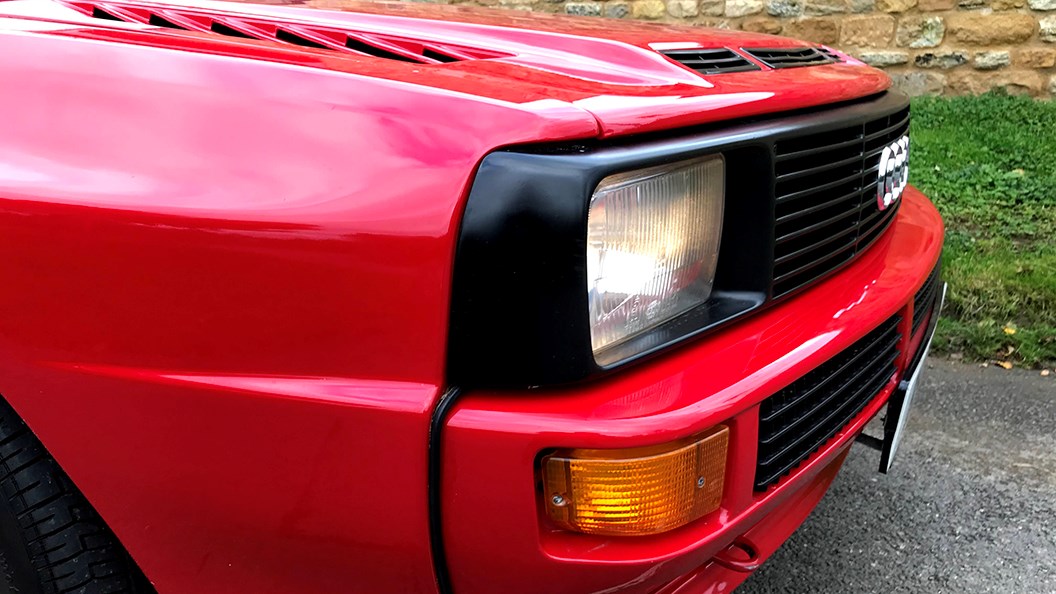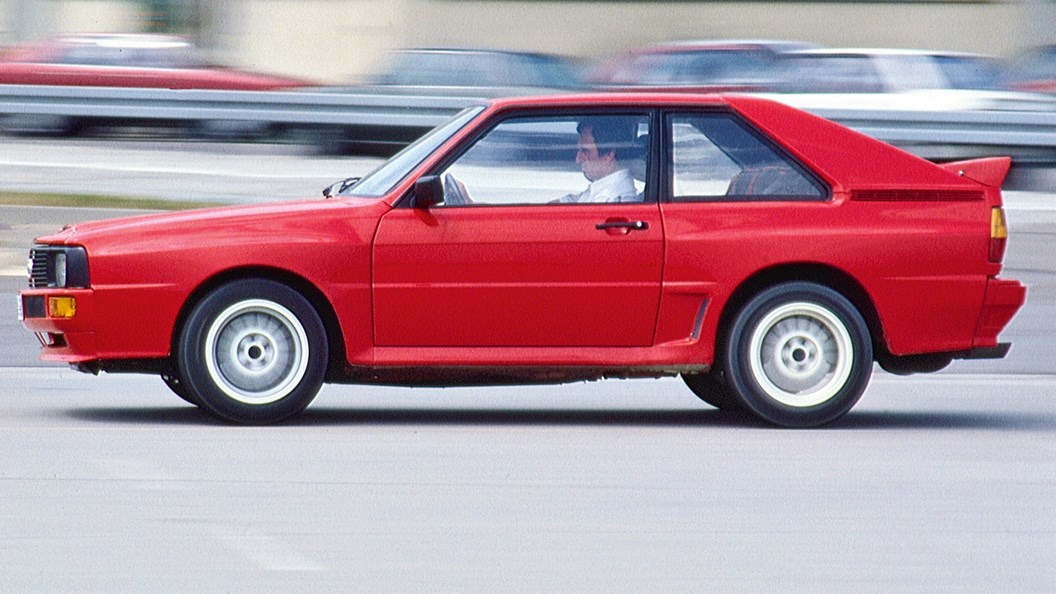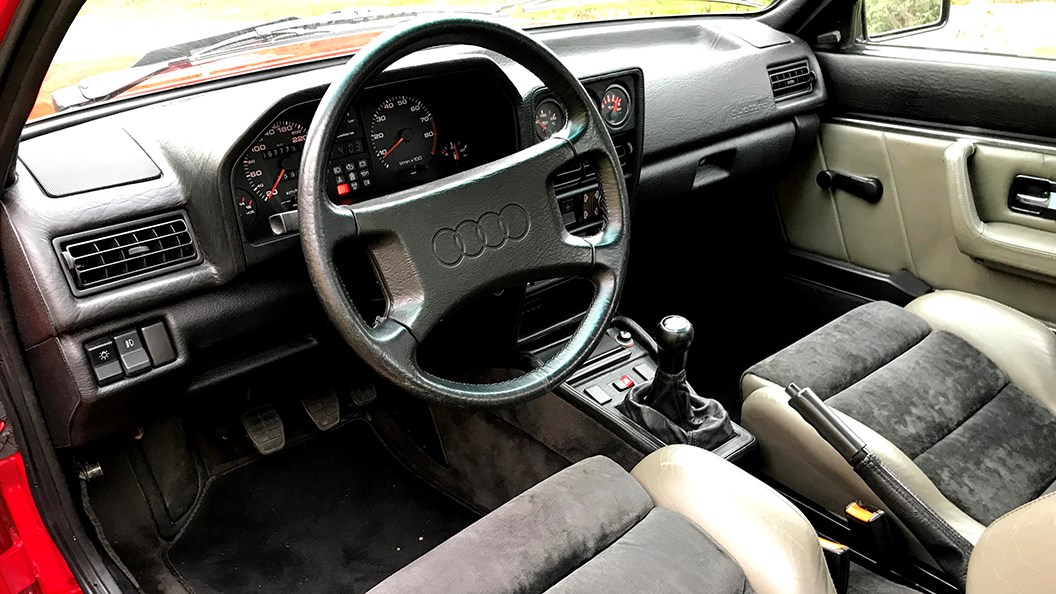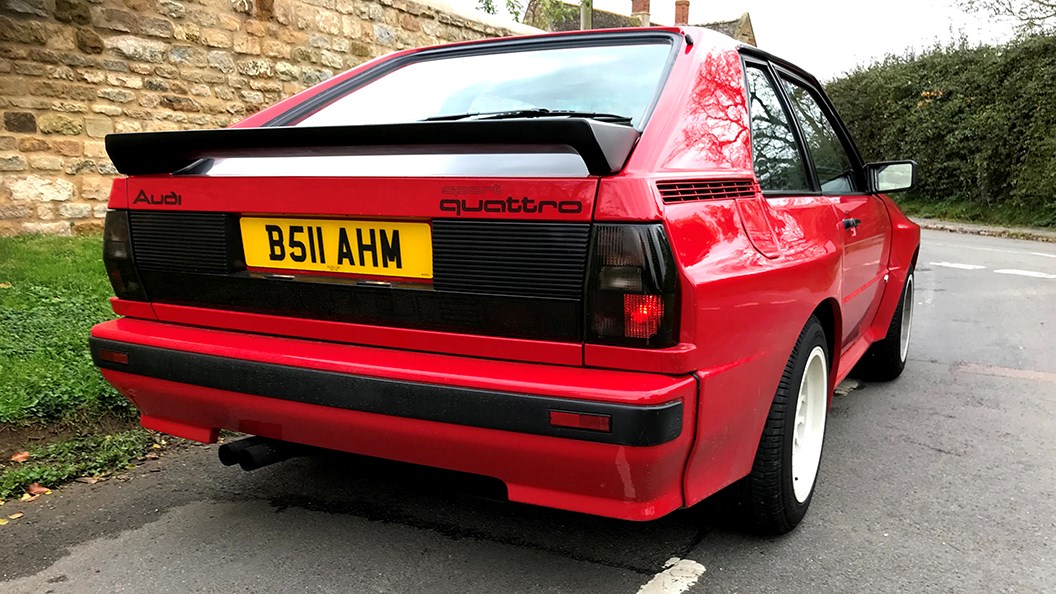Audi Quattro Top Speed
► Audi's Group B legend driven
► Built to win rallies, priced to fight Ferrari
► Huge performance, sublime handling
In 1980, the Audi Quattro was launched, and in less than a year, a Group 4 version entered its first rally and won it outright. In doing so, Ingolstadt changed the face of the sport forever, making four-wheel drive the must-have layout to win on anything other than smooth, dry tarmac. It was a simple concept, but a very clever, car – a Coupe version of the Audi 80 (B2), fitted with a turbocharged five-cylinder engine good for 200bhp, and mated to a compact differential that facilitated a 50/50 torque split between the front and rear wheels.
But it wasn't a perfect rally car – it was unweildy in tighter sections and heavy. Other manufacturers were soon catching up, too – so in order to maximise the Quattro's motor sport potential, a short-wheelbase version was conceived to make the most of the upcoming Group B regulations. For the 1983 season, manufacturers were required to build just 200 examples of their top-line rally cars (compared with 5000 of the outgoing Group 4 cars), and that encouraged them to build some frankly amazing creations.
Audi took the Group B WRC driver's titles in 1983 and '84 with the longer-wheelbase Quattro. But Group B would end up being dominated by the Peugeot 205 T16 from 1984, which had the added advantage of a mid-engined layout for better weight distribution. The Sport Quattro was Audi's riposte, but it would end up taking just two WRC victories – one in 1984 and the other in 1985. Before Group B was outlawed at the end of the 1986 season, Audi had been working on a mid-engined replacement for the Sport Quattro, which was scrapped.
What's under the skin?

In building its Group B Sport Quattro, Audi made substantial changes its donor car. The project was lead by ex-Alpina man Dr Fritz Indra, who'd been tasked by Ferdinand Piech to build a lighter, more powerful version of the company's innovative five-cylinder engine. He oversaw the development of a new alloy engine block and 20-valve cylinder head. He said at the tme, 'For this Sport Quattro engine I am told I can make a no-compromise engine – and that is why it's so good.'
The result was impressive – 302bhp at 6500rpm, capable of runing at 7300rpm for 24 hours on the testbench, and boosted by a huge KKK turbocharger running up to 3bar of boost on the road. In the end, it shared very little with the standard five cylinder engine it was based upon – even the engine capacity had changed, dropping to 2133cc (from 2144cc) in order to slip in below 3.0-litres on the FIA turbo multiplier rules.
The most obvious change to the exterior of the car is the 12.6cm reduction in the car's wheelbase. It might have been stylish and had all the proportional balance of a lump hammer, but it was certainly arresting to look at, with its wider wings, fatter wheels and a multiplicity of air intakes. Weight was quoted by Audi at 1000kg, with a 55:45% weight distribution, but the actual kerb weight ended up being around 1200kg when independently tested – still good for power to weight ratio.
In true Group B fashion, the body panels were a mixture of Kevlar and laminate glassfibre for the wings, aprons, bonnet, bootlid and roof, while the air intakes and some underbonnet components were fashioned from carbonfibre. Suspension remained pretty much unchanged from the original Quattro, with the engineer in charge of it, Thomas Ammerschlager saying, 'it's already just like a rally car with round tubes fabricated for the lower arms and Boge dampers.'
This was exotic stuff. No wonder Audi charged more than £50,000 for customer cars when it was sold on a limited basis in the UK in 1985 and '86.
What's the Audi Sport Quattro like to drive?

As you'd expect, this is an exhilarating car to drive on so many levels. For anyone around in the mid-1980s who remembers the impact this car made, the excitement begins when you first set eyes on it – it's compact, sinewy and looks as hard as nails. And when I say compact, I really mean tiny, with a foorprint that allows it to occupy less space than a modern supermini.
Once inside, it doesn't feel intimidating at all. The spindly A- and B-pillars afford fantastic forward visibility, and the driving position is more family saloon upright than supercar reclined, which suits me just fine. Fire it up (sorry...), and after a bit of churning, the five-pot settles into a surprisingly muted idle, although a blip of the throttle to clear its throat rewards you with a growling off-beat thrum that sounds wonderfully bass-laden.
Getting underway is lacking in drama. The controls are weighty, but not distractingly so, and the power delivery is progressive and tractable. Once warmed through, the first chance to lean on it doesn't take long to emerge, and flooring it in second results in it pulling relatively lazily until the turbo boost builds. At about 4500rpm, the boost gauge flicks west towards 3bar and all hell breaks loose. The engine note hardens and it all becomes an urgent blur, as it starts reeling in the horizon like a supercar should.
Gearing is well judged, and once on the boil, grabbing the next ratio keeps the turbo spinning, maintaining a seemless flow of acceleration. To get a sense of perspective, 0-60mph takes 4.8 seconds and 100 passes in 12.3 – and although something like a Honda Civic Type R or Volkswagen Golf R may go harder for longer, the sense of occasion you get when its KKK turbo is on full boost leaves these modern interlopers feeling rather digital and lacking in soul.
So it is fast in a straight line – and by mid-1980s standards between zero and 100mph, there was nothing significantly quicker available. It's a visceral and exciting experience.
But what really sets this apart from the likes of a Porsche 911 Turbo or Lamborghini Countach is just how usable it is in all circumstances. Taking it down my favourite B-road, what hits me like a hammer blow is how alive it feels in corners, how much the steering talks to me, and how planted it is when you're taking them at speed. Whereas a standard Quattro feels heavy is a bit of a lesson in understeer management, the Sport is neutral, darty and hyper responsive in comparison.
I'll be honest, this does come as a bit of a shock after decades of driving Audis, which were laced with a general feeling of lead-footed safety. Fun was rarely on the menu. That's not the case here at all, as it's fun and Audi's famed Quattro all-weather security and grip is alive and well. It's just that it's been sprinkled with feel, soul and, dare I say it, a little delicacy. There's no sense that even when really tanking on that it'll do anything untowards – something that can't be said for the 911 or Countach – nor does it ever get twitchy.
Poise and stability are first rate on more sweeping roads, too, and it's one of those cars that soon has me relaxed about driving it quickly, once its huge value is put to one side. The brakes are powerful stoppers too, which aids this reassuring feel. Clearly Audi didn't get the memo that supercars and competition machines should be difficult to drive on the road – and I applaud it for that.
What's it like inside?

Considering it's a motor sport-inspired homologation special, it's a well-trimmed, well-made place to spend time. It's based on the Audi Quattro, but it shares surprisingly little with its donor car. The Recaro seats are good looking and supportive and clamp you into a driving position that's almost perfect – a contrast to a standard UK right-hand drive Quattro, which has an offet steering wheel that forces you to set weirdly. Thankfully, it also feels better built than the B2-generation Audis it's based on - but look closely, you'll see a lot of bespoke hardware in here.
The dashboard is unique to the Sport Quattro – an anonymous-looking one-piece moulding with an instrument binnacle shared with the Audi 200. But it all works, and is more functional and usable than the supercars that it was priced again. You're in town and you can see all four corners, there's room in the cabin for your oddments, and you can even fit a fair bit of luggage space in the boot.
So are there any downsides? Well, that 12.6in wheelbase chop has been taken from the rear of the cabin. There might be two well-trimmed rear seats in there, but there is zero legroom – you'll not get a cigerette paper between the leading edge of the rear seat base and the front seat. So, it's a two seater. Use the back seats for resting your crash helmet on, or place your luggage on, and you won't go far wrong.
Audi Sport Quattro: verdict
The Audi Sport Quattro is a very, very special car. It's a fine reflection of the excess that was was Group B rallying - absolutely pointless in the development of the motor car, and not that successful in motor sport, but a gloriously capable and wonderful road car. When new, it was unlike many other homologation specials of the time, being trimmed luxuriously and sold as a top-end supercar to compete with the Porsche 911 Turbo and Lamborghini Countach. Alongside other Group B road cars, such as the MG Metro 6R4 or Peugeot 205 T16, it was highly usable and tractable.
That makes it unique today, a truism reflected in its values – £500,000 and beyond if you need to ask. Like the Porsche 911 Turbo (930) it was so often compared with, the Sport Quattro is saddled by an inherantly unweildy mechanical layout. And yet, the engineers made a rewarding driver's car, capable of firing your synapses safely in a way that no other Group B homologation special is able to.
The acceleration was right at the cutting edge in the mid-1980s, and that's still impressive today. But - and it is a big but - it's the handling that really opens your eyes in modern terms. Its ability to change direction is remarkable, especially considering just how far forward of the front axle line that five-cylinder engine lies. But it's no robotic device that's there to get from A to B devastatingly quickly without emotion – there's soul at the heart of the Sport Quattro and it's telegraphed through its steering, your backside and your ears.
So, there you have it – driving this car is a fitting way to crown the 40th anniversary of the Audi Quattro. The 1980 original rewrote the rallying rulebook, the Sport Quattro emerged as the ultimate incarnation of that car. Much of its technology ended up being honed further and mass-produced to underpin the next generation of Audi Quattro road cars that heralded the widespread adoption of four-wheel drive across the industry. That's the sensible verdict...
...the petrolhead summary is more succinct. The Sport Quattro is a brilliant, exciting, intoxicating driver's car. It's a weird, ugly and a brilliant Frankenstein's monster of a car that will excites at every turn of the wheel. I'd highly recommend buying one if you can live with its looks and have the means, but with fewer than 200 road cars made, your chances of finding one for sale are infinitessimal. Shame as I think you'd love it as much as I did.
More Audi reviews by CAR magazine

Source: https://www.carmagazine.co.uk/car-reviews/audi/sport-quattro/
